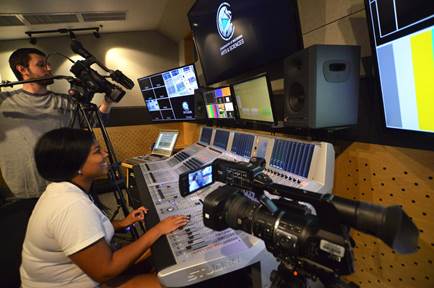Recording Arts School Adds TV Production to Curriculum With JVC

CRAS students use JVC GY-HM600 ProHD cameras to support its new focus on live broadcast production audio.
WAYNE, N.J.—The Conservatory of Recording Arts and Sciences, a Phoenix-based audio recording, engineering and production school, has purchased four JVC GY-HM600 ProHD handheld camcorders to support its newly expanded curriculum.
Beginning Oct. 25, CRAS will extend its 30-week master recording program to 36 weeks for new students, adding live broadcast production audio as an educational focus.
The JVC cameras will be shared between a new control room and 42-foot production expando trailer, which have been outfitted with oversized audio areas.
“We built a broadcast production facility with a basic switching system for the purpose of teaching how audio integrates into television production,” said Robert Brock, director of the CRAS Digital Department.
The CRAS curriculum is intended to help students prepare for a career in audio by exposing them to various facets of audio production. As part of the new coursework, CRAS students will produce real video coverage of live events. The JVC cameras will usually be mounted on Manfrotto tripods with external zoom controls for studio exercises, but will also be used for ENG and film-style projects.
Regardless of their major interest of study, every student will have hands-on experience with the JVC ProHD cameras. “We’re not teaching video production, but the creation of multimedia content is part of what schools need to do,” Brock said. “It exposes our students to a real broadcast environment and the bigger picture of what broadcast television is all about. These skills will apply to a number of employment opportunities.”
CRAS had three minimum requirements for its cameras: XLR inputs, SDI output and time code capability. Brock said the GY-HM600’s use of non-proprietary SDHC media cards was a “strong bonus.” Plus, with native file recording of .MOV footage, the cameras provided a “nice, easy workflow” for the school’s Final Cut Pro NLE workstations.
“In support of creating our curriculum, we’re starting to shoot more content,” Brock said, explaining that faculty members have been shooting interviews, guest speakers and other events since the spring purchase.
Much of the footage being shot by CRAS is in recording studios, where work areas generally have dim lighting and light kits are not an option. As a result, the GY-HM600’s low-light sensitivity has been helpful, according to Brock. He also appreciates the built-in 23x zoom lens, which captures close-up footage of guest speakers from the back of the 6,000-square-foot conservatory.
With a focus on audio, not video, the new CRAS control room and expando truck are designed with very large audio areas and small, simplified video sections, the opposite of traditional video production facilities. When shooting in more traditional trucks, with noticeably more compact audio areas, Brock said the GY-HM600 has also performed very well.
The professional video industry's #1 source for news, trends and product and tech information. Sign up below.
